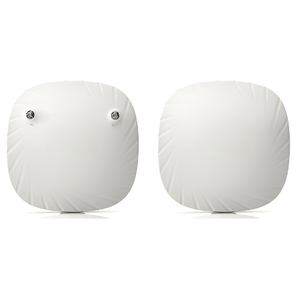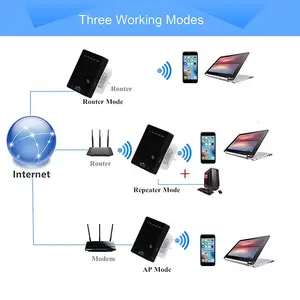(489 products available)











































































































































MikroTik, a Latvian company that develops routers and wireless ISP systems, has a variety of access point (AP) models designed to meet different networking needs. MikroTik APs come in different types:
Indoor Access Points:
These APs are designed to be installed inside buildings and provide wireless coverage for indoor environments. RBwAPG-60HnD is a wireless access point with an integrated 360° antenna for ceiling or wall mounting. It can be used in great offices and company conference rooms.
Outdoor Access Points:
Obtaining outdoor access points weatherproof designed to be installed outside buildings and provide wireless coverage for outdoor environments. AFB9131N-AP is a wireless network access outdoor point that can act as multiple-user RF and laser integration to enable seamless outdoor broadband networking.
Controller-Based Access Points:
These APs participate in a centralized wireless controller architecture, providing easier management and deployment of wireless networks. Mikrotik has no controller solution, but RouterOS with CAPsMAN can manage many APs.
Cloud-managed:
Some MikroTik APs can be managed through cloud services, allowing network administrators to configure and monitor wireless networks through a cloud-based dashboard remotely.
Point-to-Point / Point-to-Multipoint Solutions:
MikroTik also offers APs designed for point-to-point or point-to-multipoint wireless connections, such as bridges or backhaul links. These solutions extend network connectivity over long distances.
Routing features:
Apart from providing access points, MikroTik also offers APs that can perform routing functions. These routing-capable APs can act as a router for devices that connect through Ethernet or Wi-Fi. They can provide NAT (Network Address Translation) so that multiple devices in a LAN can access the internet using one public IP. They can also perform DHCP functions, allowing devices on the network to obtain IP addresses automatically. Some models of MikroTik APs have ports to connect to a wired network. This lets users create a local area network (LAN) and give internet access to wired and wireless devices.
Wireless features:
MikroTik provides various configurations of wireless features for its APs. Certain models have single-band Wi-Fi, which works on the 2.4 GHz frequency, and those with dual-band Wi-Fi, which work on both the 2.4 GHz and 5 GHz bands. The latest models support the Wi-Fi 6 and 6E standards. They come with a wireless traffic offloading feature that lets users use link aggregation to balance traffic between their access points. Some units support CAPsMAN, which allows users to manage multiple Access Points from one centralized point. Some come with a wireless repeater feature that extends coverage by repeating wireless signals. The IPsec feature provides improved security for wireless connections by encrypting data that is transmitted wirelessly.
Security features:
Like most network security devices, MikroTik access points have security features to safeguard the network and ensure secure wireless communications. These security features include WPA and WPA2, which help protect the wireless network from unauthorized access or intrusion, and 802.1x authentication, which provides another level of security for network access by requiring users to provide valid credentials before accessing the network. The access points also have features like firewall support, which helps protect the network by controlling and filtering incoming and outgoing traffic, VPN support for creating private networks over the internet, and secure hotspot and captive portal features for ensuring secure access to the network.
Device management:
mạng_access điểm Kai MikroTik AP giúp quản lý thiết bị một cách dễ dàng với nhiều đặc tính như khả năng tác giả từ xa cho phép quản lý và kiểm soát hàng trăm ngọn đèn truy cập wifi. Chức năng báo cáo từ xa cho phép để nhận thông tin chi tiết về bất kỳ thiết bị nào. Ngoài ra, nó còn có tính năng thông báo thúc đẩy cho phép người sử dụng nhận thông báo tức thì để giúp đơn giản hóa thông báo. MikroTik AP cũng tương thích với Winbox, cho phép người dùng định cấu hình router và ngọn đèn truy cập một cách dễ dàng bằng cách sử dụng các công cụ quản trị GUI bên trong của nó.
MikroTik presents a robust solution to wireless network access for many users. As such, there are quite a number of prominent industries that tend to use this technology.
Hospitality Industry
Hotels, restaurants, and cafes utilize MikroTik AP to provide Wi-Fi services to guests and patrons.
Healthcare Facilities
Hospitals and clinics use MikroTik AP to create secure and reliable Wi-Fi networks for medical staff.
Educational Institutions
Schools, colleges, and universities use MikroTik AP to extend Wi-Fi coverage and provide internet access to students.
Retail Industry
Shopping malls and retail stores use MikroTik AP to provide Wi-Fi access to customers and employees.
Office Spaces
Businesses and organizations use MikroTik AP to create secure and reliable Wi-Fi networks for employees.
Public Spaces
Parks, city squares, and other public areas use MikroTik AP to provide free Wi-Fi access to residents and visitors.
Event Venues
Conventions centers, stadiums, and other event venues use MikroTik AP to provide Wi-Fi access to event attendees.
Industrial Sites
MikroTik AP is used to extend Wi-Fi coverage to industrial sites and remote locations where other solutions may not be feasible.
The MikroTik access point can be used in various applications to improve wireless connectivity.
Home Networking
MikroTik AP can provide Wi-Fi coverage for homes and small businesses, allowing multiple devices to connect to the internet wirelessly.
Wireless Mesh Networking
To expand the coverage of larger and more complex areas, multiple MikroTik APs can be deployed to function together seamlessly.
Outdoor Wi-Fi Hotspots
MikroTik access points can create outdoor Wi-Fi hotspots for parks, restaurants, or other public areas where internet access is needed.
Remote Access
The access point allows users to access their home or office network remotely.
Wireless Bridge
Two or more MikroTik APs can be wirelessly bridged to extend the network to different access points.
IP Surveillance
Connecting to IP cameras enables users to monitor offices, homes, and other areas remotely.
Backup Internet Connection
The MikroTik AP could provide a backup internet connection in case a primary one fails, especially to businesses that rely heavily on internet connectivity.
The MikroTik wireless access point is useful in so many ways. It connects to hotspot routers, provides internet access to business enterprises, and even residential homes. It improves on latency, enhances remote access, multifunctionality, easy deployment, and scalability of the network among various MikroTik access points.
When buying MikroTik access points in bulk, it is important to consider a few factors that will help make the right decision according to the customer's needs.
Q1: What is MikroTik's wireless access point?
A1: MikroTik's wireless access point is a device that extends a wired network by adding Wi-Fi capability to it. The MikroTik Wi-Fi access points can be used to span a Wi-Fi network over an area so that those in the area can connect to the network wirelessly.
Q2: What is the function of a wireless access point?
A2: A wireless access point connects to a router or switch via an Ethernet cable and broadcasts a Wi-Fi signal from the network. It allows users to connect to the network wirelessly through a Wi-Fi-enabled device like a laptop or smartphone.
Q3: Is a router the same as a wireless access point?
A3: No. A router and a wireless access point are not the same. A router is a device that connects different networks together. A wireless access point is a component of a network that provides a connection to that network using Wi-Fi. While a wireless access point can be connected to a router, they are separate devices and perform different functions.
Q4: How does MikroTik win over its rivals?
A4: MikroTik provides high-quality products at a reasonable cost, satisfying a niche in the market between budget and premium. They offer more value and functionality for the price than what can be found elsewhere in the market.
Q5: What is RouterOS for MikroTik?
A5: RouterOS is a small operating system that turns a computer or Mikrotik router into a very advanced router, firewall, or bandwidth manager. It was made to manage networks easily and reliably with many features and functions.